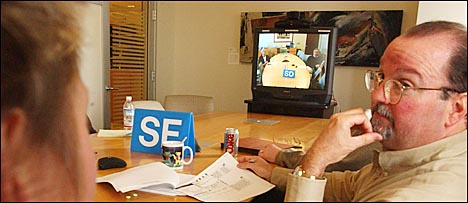Travel Fears Cause Some to Commute Online
By JONATHAN D. GLATER, New York Times
 |
| Brian Bailey-Gates, a technology services manager at the Morrison & Foerster law firm in San Francisco, chats with a colleague at the table and others via videoconference in the firm's San Diego office. |
The Sprint Corporation has seen minutes spent on teleconferences spike in recent months, rising 23 percent in March from February, and 58 percent from March of last year for its top customers, according to Jackie Bostick, a spokeswoman for the company. Sprint expects to have more growth in the coming weeks as businesses squeezed by the slow economy and constrained by travel fears switch to Web-conferences, video conferences and old-fashioned telephone conference calls.
AT&T has also experienced an increase in use recently, said a spokesman, Michael P. Cuno. "It's nothing that we would attribute to the Middle East situation per se," Mr. Cuno said. "The trend that we're seeing has developed over several months."
Increases in investments in technology that allow companies to hold virtual meetings and employees to work remotely date back to the weeks and months after Sept. 11, according to telecommuting consultants. Now some executives and employees say the new capabilities are beginning to be used more often, though teleconferencing is still a tiny fraction of what is spent on regular telephone calls or on business travel.
At Fulbright & Jaworski, a law firm based in Houston, more lawyers are holding meetings using videoconference technology: 13 last month, compared with just four or five a month last summer. Likewise, lawyers at Morrison & Foerster, a large law firm with several offices in Asia, "certainly are using our teleconferencing capability a lot more," said Keith Wetmore, the firm's chairman.
And at HSBC, which has curtailed all non-essential travel to Hong Kong, Singapore and Vietnam as a result of concerns about SARS, or severe acute respiratory syndrome, a spokeswoman said that teleconferences and videoconferences would probably become more common.
But technology is not always a substitute for an in-person meeting, especially one involving a large group of people. "It's not really practical to say no one's going to travel between the China offices," Mr. Wetmore said.
The Sept. 11 attacks forced companies to evaluate telecommuting and teleconferencing as part of their business plans, said Timothy J. Kane, chief executive of Kinetic Workplace, a consulting firm in Pittsburgh. "Many of those programs are up and in place now," he said.
But several consultants said they doubted the use of virtual meetings and telecommuting would necessarily increase. "After 9/11, we conducted a survey to see how that changed attitudes," said Bob Smith, executive director of the International Telework Association and Council, or ITAC. "It changed a bit, but quite frankly not dramatically."
Spokesmen for several companies agreed that the shift has not been drastic. "It's an ongoing activity, making good use of whatever technology we have available," said Gerald Davis, a spokesman for Sunoco. "I wouldn't say that because of the geopolitical situation and the strife and the war that we have altered any activities, but you always have to be prudent," he said.
IBM, where more than one-third of the company's roughly 310,000 employees already work from remote locations using laptops and other tools, has developed its own technology so that employees can hold teleconferences more easily, said Jim Sinocchi, a spokesman for the company. "What we've done over the past five years or more is start to deploy the equipment," Mr. Sinocchi said. "When world events mandate that you not travel for any reason, we're already set up."
Employees at Cisco Systems, a high-tech company, have also already grown accustomed to meeting via Internet or by videoconferences, said Abby Smith, a company spokeswoman. And at AT&T, 17 percent of managers work full time as telecommuters, said Joseph Roitz, who coordinates and directs such work at AT&T. "We've seen an upswing in terms of our employed teleworkers. But it goes back several years, even before 9/11," he said. "The big driver is really time. I don't really see fear driving a lot of the telework. I haven't seen any major upswing in demand since the whole Iraq thing kicked off."
Identifying any such increase in teleconferencing and telecommuting is difficult. "There aren't surveys or polls," said Joanne H. Pratt, head of Joanne H. Pratt Associates, which studies telecommuting trends.
She pointed out that people are now better equipped to work from home because of broadband connections to the Internet. Still, Ms. Pratt said she was disappointed that more companies were not more generous in providing technology to support telecommuting. "I think it's still the reluctance of management to trust that employees will work when they're at home," she said.
But companies that provide products and services for virtual meetings and telecommuting are optimistic. Pixion, a 45-employee company in Pleasanton, Calif., that markets software to hold conferences on the Web, is hoping for a big increase in demand, and recently offered free Web conferencing to the first 5,000 American companies to sign up.
"We've been seeing a lot of interest," said Charles Orlando, the director of marketing for Pixion, which is privately held and does not disclose sales information.
CKE Restaurants, owner of restaurant chains including Hardee's, is a Pixion client. Travel has dropped as much as two-thirds for some categories of employees, said Tom Lindblom, CKE's chief technology officer. While the company's road warriors are still traveling, he said, other employees - trainers, product development experts and others whose jobs do not require constant travel - are now much more likely to stay where they are.
"We don't require people to travel who aren't comfortable traveling," Mr. Lindblom said.
©2003
The New York Times Company